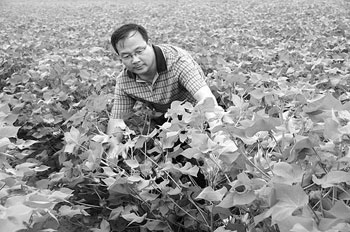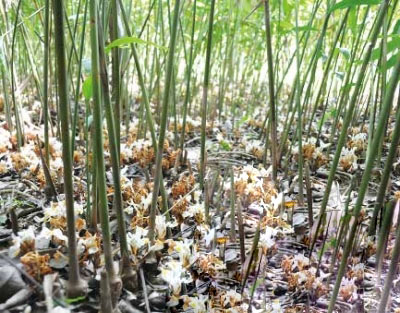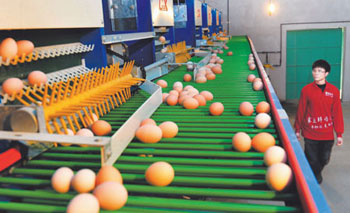"drudgery" is coincidentally simplified by Dong Hezhong's "Happy Cotton planting"
Original title: Dong Hezhong: light Jane planting cotton is happy in it.

Dong Hezhong is in the cotton field.
In Shandong Academy of Agricultural Sciences, there is a scientist who keeps company with cotton all day long, from the Yellow River valley to the northwest inland, from the southwest of Shandong to the north of Shandong, leaving his figure everywhere in the endless cotton fields. He is Dong Hezhong, director of the Cotton Research Center of the Shandong Academy of Agricultural Sciences, and a cotton expert who has won 16 national and provincial scientific and technological achievements awards, including four of the second prize of the National Scientific and technological Progress Award.
Recently, the reporter met him at the Shandong Academy of Agricultural Sciences.
Dong Hezhong, who has been watching the cotton field for more than 20 years, has a simple idea: to make more contributions to China's cotton cause. "as agricultural science and technology workers, on the one hand, they should produce more new technologies and achievements, and on the other hand, they should also give more good suggestions to the state decision-making departments."
Grow cotton happily
Yu Shuxun, a famous cotton expert and academician of the Chinese Academy of Engineering, once proposed to let cotton farmers "plant cotton happily", and this is also one of Dong Hezhong's wishes.
Cotton is an important economic crop in China, but growing cotton is a "hard job". In recent years, with the transfer of rural labor force and the rapid increase of labor costs, the traditional cotton planting method of intensive cultivation can no longer meet the needs of production, which has seriously restricted the sustainable development of cotton production. Therefore, the realization of light and simple cotton production, cost-saving and efficient, happy cotton planting has become the inevitable requirement of the development of cotton industry. To achieve this goal, we first need to have the corresponding scientific and technological support.
In order to break through the predicament, Dong Hezhong fought in the forefront of cotton cultivation and breeding for a long time, and devoted almost all his painstaking efforts to cotton scientific research. Kung Fu is worthy of painstaking efforts, and the innovative team led by him has studied and established the "cotton chemical light simplified cultivation technology", which provides a strong scientific and technological support for happy cotton planting.
For a long time, cotton planting in China has been scattered by households, and the large-scale mechanized and intelligent operation in the West is not suitable for China's national conditions, so we can only take the way of agricultural technology with Chinese characteristics. According to the actual conditions and production needs, Dong Hezhong's team focused on strengthening the research on key technologies such as precision sowing, simplified pruning and one-time fertilization, and first made a breakthrough in planting and management around 2010. a light and simplified cultivation technique was established, which is based on the determination of seedlings between the reduction and reduction of precision sowing, reasonable close planting and the combination of chemical regulation and control, and the combination of controlled release fertilizer and quick-acting fertilizer to realize primary fertilization. Under the premise of ensuring that the per unit yield of cotton is not reduced or even slightly increased, labor employment is reduced by more than 40%.
Take sowing as an example, in the past, cotton was sown in large quantities or in sufficient quantities, and it took 8 kilograms of seeds per mu of land. There are about 5000 seeds per jin. If the emergence of 50, 000 seeds is calculated at 70%, there will be more than 30, 000 seedlings, but only 3, 000 and 4, 000 seedlings are needed in the field, so it is necessary to constantly carry out the work of thinning, interplanting and fixing seedlings, which is labor-consuming and time-consuming, and seeds are also wasted. After precision sowing, only 2 kilograms of seeds are needed, and as long as the seedlings are slightly adjusted, the links such as thinning, interplanting and fixing seedlings can be reduced, which greatly reduces the workload and saves the amount of seeds.
"the light and simplified cultivation technology of cotton is a practical technology based on scientific research and practice. in order to facilitate the acceptance of farmers, we have carried out scientific 'packaging' and 'popularization' treatment. Make it a kind of 'fool' technology that is easy to understand and easy to operate. When we teach technology, we can tell the people a general truth and a general scope, and they can carry out planting operations within this scope. Is to make it easy for ordinary people to understand and master. " Dong Hezhong said.
In order to realize light and simple cotton planting and happy cotton planting in the real sense, cotton planting must be mechanized in the whole process. Therefore, recently, Dong Hezhong is mainly committed to studying the whole process of mechanized cotton production technology.
The mechanized cotton planting technology in the whole process of cotton planting in developed countries such as the United States and Australia has been very mature, and the inland cotton area in northwest China (*) has also been popularized and applied on a large scale. However, due to the differences between production and ecological conditions and planting methods, Shandong can not completely copy foreign and existing cotton mechanization production technology. For this reason, Shandong Cotton Research Center has carried out the research on the whole process of mechanized cotton production, focusing on the key technologies such as cotton variety selection and breeding, reasonable close planting, chemical regulation, defoliation and ripening.
"We have established the agronomic technology of mechanized cotton picking based on precision sowing and concentrated boll formation, using mechanical harvesting instead of manual harvesting, basically realizing the mechanization of cotton production and promoting the organic integration of agricultural machinery and agronomy. the employment of cotton planting will be reduced from about 25 in the past to about 6."
In order to promote new technology, Dong Hezhong often needs to go to the grass roots. More than 20 technical training courses are organized every year, many of them in the fields or even at night. "in the evening, I will set up a screen in the yard of the village branch secretary, just like the movie used to be shown. It can summon 40 to 50 people. I will speak for an hour and set aside an hour to take questions. The effect is very good."
"there are some questions raised by ordinary people that I have not come into contact with, and these questions are likely to become our next research topic." One of the projects that Dong Hezhong won the second prize of the National Science and Technology Progress Award is "the establishment and application of the high-yield cultivation technology system of cotton in coastal saline-alkali land." the proposal of the project stems from the questions raised by farmers, and the solution to the problem comes from the field.
From the field to the field.
Planting cotton in saline-alkali land in coastal area is faced with many difficulties, such as difficulty in seedling formation, difference in maturity, low fertilizer efficiency, excessive labor and so on. In view of these difficulties, Dong Hezhong and his colleagues carried out research and achieved good results.
"to grow cotton in saline-alkali soil is to plant cotton in a ditch. In fact, the source of this technology is not invented by me, but by ordinary people." Dong Hezhong said frankly.
Fifteen years ago, Dong Hezhong inspected the growth of cotton in the saline-alkali land of Dongying and found that the cotton seedlings on the saline-alkali land were uneven. "most saline-alkali cotton fields are uneven, resulting in uneven salt distribution and salt spots everywhere. as long as salt spots are encountered, cotton dies, resulting in serious lack of seedlings and broken ridges in saline-alkali cotton fields. Farmers are very upset about this. Every time they give a lecture, some farmers raise this problem and hope to solve it. " Dong Hezhong recalled.
But he accidentally found that the common people randomly sowed seeds in the watering ditch next to the field, but the cotton seedlings in the ditch were all seedlings and all the seedlings were strong. Dong Hezhong immediately took soil samples from watering ditches and field ridges, and found that the salt content in the central area of the ditch was the lowest, the highest on the ridge, and the salt concentration decreased from ridge to ditch and from top to bottom. Dong Hezhong found that the secret lies in the movement of salt with water. "Salt dissolves into soil water in the ground, and salt moves with the water. The higher the water is, the greater the water evaporation. After the water evaporates, the salt remains in the soil, causing the salt to climb up."
Dong Hezhong's team also invented the grafting root splitting method, accurately simulated the differential distribution of salt in the root zone in the laboratory, and revealed the mechanism of salt differential distribution from different levels of physiology and molecular biology. On this basis, the furrow plastic film planting technology which can be used to induce salt difference distribution in root zone and promote cotton seedling formation in field was designed, and the supporting machinery was developed. The physiological ecology and cultivation techniques of cotton in coastal saline-alkali land came into being. Dong Hezhong team put forward the theory of salt difference distribution in root zone to promote cotton seedling formation, and established new techniques to induce salt difference distribution in root zone, such as furrow plastic film planting, pre-film mulching cultivation, short-season cotton late spring sowing and positioning drip irrigation, to achieve seedling protection and yield increase, and to achieve one sowing and whole seedling in saline-alkali land with salt content less than 0.7%.
- Prev

Artificial pollination of Amomum villosum in early summer and early spring
Artificial pollination of Amomum villosum in early summer and early spring
- Next

"eat dry and squeeze clean" what to do with the waste shell film of an egg
"eat dry and squeeze clean" what to do with the waste shell film of an egg
Related
- A course of planting techniques and methods on how to grow carrots
- How to plant the latest tulips?
- Is it better to pick tea in the morning or in the afternoon? When is the best time for tea to be picked? what is the third or fifth tea?
- Launch Yuanxiao Happy combination Haocha + Tea Yuan healthy Taste
- Penghu Tourism "Fireworks 20 Parade with You"
- 2022 West Lake Happiness holds "Digital Revitalization Voucher" and draws iphone13 and laptop.
- Banqiao Fuzhou social houses are designed to change start-up combined with police elimination to create a safe and livable environment
- The convenient measure of "mechanical weeding" in Xinbei has been abused and the Agriculture Bureau has imposed heavy penalties on the illegal land consolidation.
- Changgeng University Joins Hands with Four Memory Factories to Rescue Memory Talent Shortage
- The list of Taiwan's top 100 MVP managers is listed by the Director-General of the Farmers' Association of Sanxia District.

